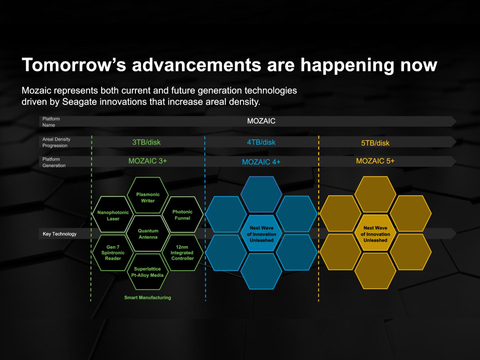Seagate® Technology Holdings plc (NASDAQ: STX), a world leader in sustainable mass-data storage solutions, today announced a milestone that marks a new era in the storage industry.
This press release features multimedia. View the full release here: https://www.businesswire.com/news/home/20240117730823/en/

Mozaic 3+ is ramping volume, Mozaic 4+ is in productization phase with good internal results, and Mozaic 5+ has been demonstrated in lab tests. (Graphic: Business Wire)
The company launched the Mozaic 3+™ hard drive platform—which incorporates Seagate’s trailblazing implementation of Heat-Assisted Magnetic Recording (HAMR) technology. The launch heralds unparalleled areal densities of 3TB+ per platter—and a roadmap that will achieve 4TB+ and 5TB+ per platter in the coming years.
The Mozaic 3+ platform powers Seagate’s flagship Exos® product family, with newly announced, industry-leading capacity points of 30TB and beyond. Exos 30TB+ products are shipping in volume this quarter to hyperscale cloud customers.
Seagate’s areal density innovation—which increases the number of bits that can be stored on a platter—addresses common industry pain points. Mozaic 3+ enables customers to store more data in the same floor space than ever before. Upgrading from a 16TB conventional perpendicular magnetic recording (PMR) drive (the average capacity in large-scale data centers) to an Exos 30TB Mozaic 3+ technology drive effectively doubles capacity in the same footprint.
The platform uses roughly the same material components as PMR hard drives while dramatically increasing capacity, allowing data centers to significantly lower storage acquisition and operational costs—including a 40% improvement in per terabyte power consumption. Mozaic 3+ can also help customers achieve sustainability goals—a top priority for large-scale data centers—by offering a 55% reduction in embodied carbon per terabyte (when comparing a 30TB Mozaic 3+ drive with a traditional 16TB PMR drive).
Seagate is experiencing strong demand from data center customers that are expected to complete qualification of Mozaic 3+ and move into volume ramp by end of this quarter. A leading cloud service provider is focused on ramping of Seagate-provided drives to Mozaic 3+, reflecting their confidence in the technology.
“Seagate is the world’s only hard drive manufacturer with the areal density capability to get to 3TB per platter and with 5TB on the horizon,” said Dave Mosley, Seagate’s CEO. “As AI use cases put a premium on raw data sets, more companies are going to need to store all the data they can. To accommodate the resulting masses of data, areal density matters more than ever.”
“The Mozaic 3+ platform represents more than just HAMR technology,” Mosley noted. “It comprises several industry-first innovations that we’ve integrated to help us scale areal density.”
Here are a few highlights:
1. Superlattice Platinum-Alloy Media. Fundamental physics of higher-density recording requires smaller media grain size at nanoscale. The challenge here is that smaller grains are more unstable. Legacy alloys do not provide sufficient magnetic stability for effective and reliable storage. In Mozaic 3+ hard drives, the media alloy uses a pioneering iron-platinum superlattice structure, which significantly increases the magnetic coercivity of disk media. This allows for precise data writing and unprecedented bit stability.
2. Plasmonic Writer. Since the media are made magnetically “harder” to prevent instability, the design requires a revolutionary writer—a marvel of miniaturization and precision engineering that is Seagate’s unique implementation of HAMR. Anchoring this technology is a nanophotonic laser, which produces an infinitesimal heat spot on the media surface to reliably write the data.
Seagate plans to vertically integrate the nanophotonic laser into the plasmonic writer sub-system. “Developing this unique laser technology in-house for Mozaic 3+ will ensure even greater efficiency and yield to support rapid scaling of volume production,” Mosley said.
3. Gen 7 Spintronic Reader. Smaller grains of written data are only useful if they can be read. Integrated along with the sub-components of the plasmonic writer, the reader also needed to evolve. Incorporating quantum technology, Mozaic 3+ includes one of the world’s smallest and most sensitive magnetic field reading sensors.
4. 12nm Integrated Controller. Efficiently orchestrating all this technology called for an integrated controller, a system-on-a-chip, developed entirely in house. This sophisticated application-specific integrated circuit delivers up to 3 times the performance compared to prior solutions.
“Hard drive areal density improvements are critical for economically and efficiently expanding the installed base of hard drive-based mass storage, especially in data centers,” said John Rydning, Research Vice President, IDC Global DataSphere. “Seagate’s innovative areal density breakthrough is timely and will enable it to deliver increasingly higher capacity hard drive products for many years.”
In addition to data centers, Mozaic 3+ storage technology will enable a wide range of use cases, ranging from enterprise, to edge, NAS, and video and imaging applications (VIA) markets.
To learn more about Mozaic 3+ technologies and products, visit this page. Images and supplementary materials can be found here.
About Seagate Technology
Seagate Technology is the leading innovator of sustainable mass-capacity data storage solutions. We create breakthrough technology so you can confidently store your data and easily unlock its value. Founded over 45 years ago, Seagate has shipped over four billion terabytes of data capacity and offers a full portfolio of storage devices, systems, and services from edge to cloud. To learn more about how Seagate leads storage innovation, visit www.seagate.com and our blog, or follow us on Twitter, Facebook, LinkedIn, and YouTube.
©2024 Seagate Technology LLC. All rights reserved. Seagate, Seagate Technology, Mozaic 3+, Exos, and the Spiral logo are trademarks or registered trademarks of Seagate Technology LLC in the United States and/or other countries. All other trademarks or registered trademarks are the property of their respective owners. When referring to drive capacity, one gigabyte, or GB, equals one billion bytes, one terabyte, or TB, equals one trillion bytes, and one exabyte, or EB, equals one quintillion bytes.
View source version on businesswire.com: https://www.businesswire.com/news/home/20240117730823/en/